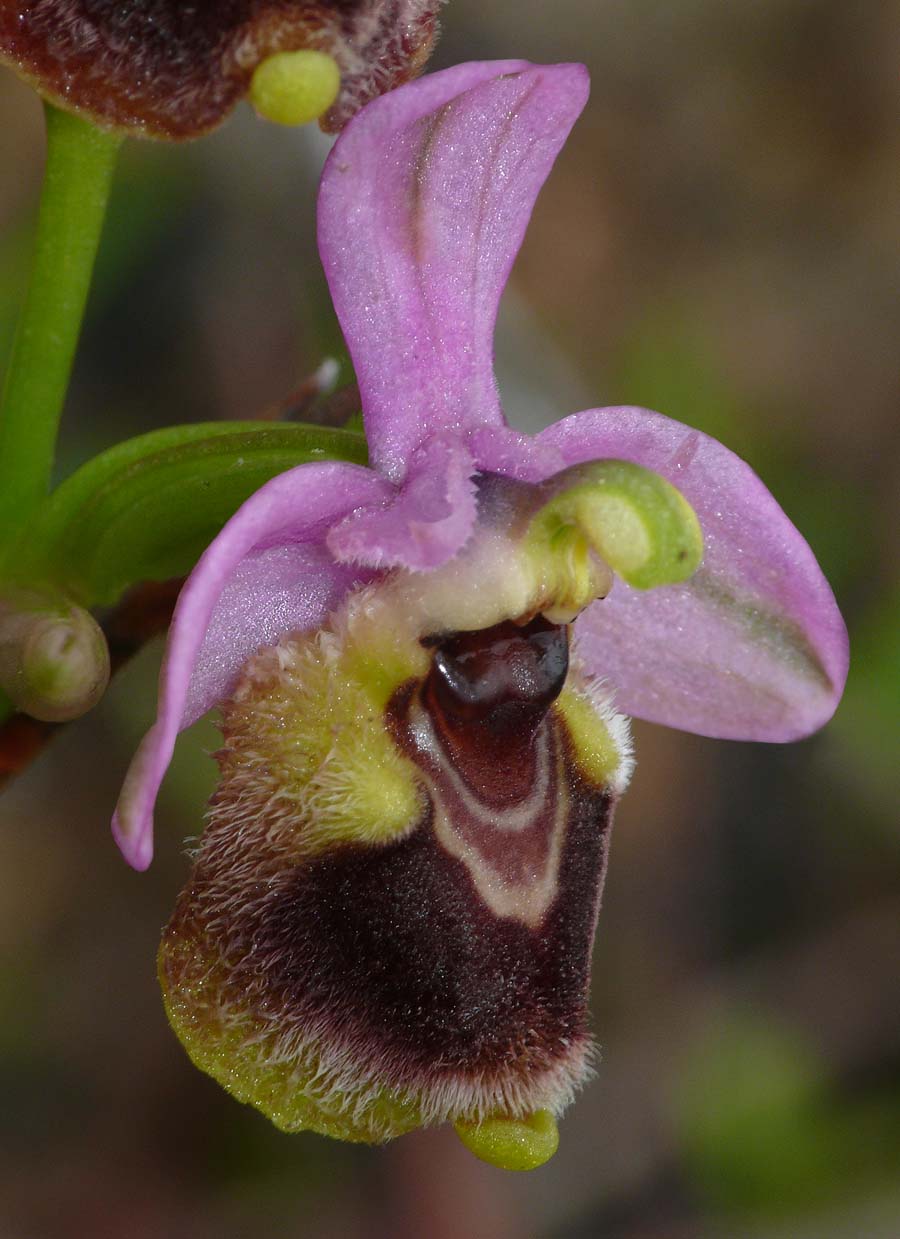O. dimidiata was first described by Rakosi, Paulus and Hirth from Crete in 2020 and is a member of the O. tenthredenifera group of Ophrys. Its name refers to the species pollinator, Eucera dimidiata.
Until very recently this taxon was considered to be within the natural varietal range of O. villosa but painstaking study has revealed that despite the taxons close anatomical and morphological resemblance to that species, the plants were in fact being pollinated by a different wild bee, namely Eucera dimidiata. It therefore became the latest of six new species split away from the original aggregation of variations that were conveniently held under the O. villosa umbrella. Of these six (O.leochroma, O. sanctae-marcellae, O. korae, O. dictynnae, O. ulyssea and O. dimidiata) the latter is much the more difficult species to identify in the field as it is virtually indistinguishable from O. villosa. It is endemic to Crete where along with the inseparable O. villosa, it is accompanied by O. dictynnae and O. leochroma, both of which are bigger flowers and can be more easily differentiated.
As has been mentioned, O. dimidiata is currently known only from Crete where it appears to be well distributed around the island and not particularly scarce. This is clearly a taxon that requires further research but given that its pollinator has a wider range in the eastern Mediterranean, it would seem entirely possible that this orchid also grows elsewhere, masquerading as O. villosa. In the absence of more detailed diagnostic markers the only way to distinguish this species is to identify its visiting pollinator or as is the case here, be pointed in the right direction by higher authority ! It should be stressed however that the illustrations cannot be guaranteed as O. dimidiata, only that they were growing in a known location. Pictures 4 and 10 depict flowers which conform very closely to O. sanctae-marcellae, a species thought to be restricted to the eastern Aegean ?
The pictures are from the Rethymnon district of Crete, dating from the first week of April.
Until very recently this taxon was considered to be within the natural varietal range of O. villosa but painstaking study has revealed that despite the taxons close anatomical and morphological resemblance to that species, the plants were in fact being pollinated by a different wild bee, namely Eucera dimidiata. It therefore became the latest of six new species split away from the original aggregation of variations that were conveniently held under the O. villosa umbrella. Of these six (O.leochroma, O. sanctae-marcellae, O. korae, O. dictynnae, O. ulyssea and O. dimidiata) the latter is much the more difficult species to identify in the field as it is virtually indistinguishable from O. villosa. It is endemic to Crete where along with the inseparable O. villosa, it is accompanied by O. dictynnae and O. leochroma, both of which are bigger flowers and can be more easily differentiated.
As has been mentioned, O. dimidiata is currently known only from Crete where it appears to be well distributed around the island and not particularly scarce. This is clearly a taxon that requires further research but given that its pollinator has a wider range in the eastern Mediterranean, it would seem entirely possible that this orchid also grows elsewhere, masquerading as O. villosa. In the absence of more detailed diagnostic markers the only way to distinguish this species is to identify its visiting pollinator or as is the case here, be pointed in the right direction by higher authority ! It should be stressed however that the illustrations cannot be guaranteed as O. dimidiata, only that they were growing in a known location. Pictures 4 and 10 depict flowers which conform very closely to O. sanctae-marcellae, a species thought to be restricted to the eastern Aegean ?
The pictures are from the Rethymnon district of Crete, dating from the first week of April.









